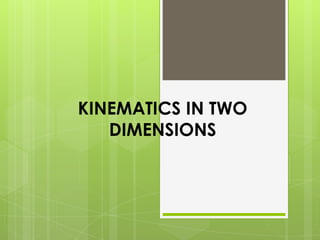
Chapter 06 kinematics in two dimensions
- 1. KINEMATICS IN TWO DIMENSIONS
- 2. Recall: Polar to Rectangular 𝒔 𝒙=𝐬𝐜𝐨𝐬𝜽 𝒚=𝐬𝐬𝐢𝐧𝜽 𝒚 𝜃 𝒙 𝒙 𝒔 To find if and are given: 𝒚 𝒔=𝒙𝟐+𝒚𝟐 𝜽=𝐭𝐚𝐧−𝟏𝐨𝐩𝐩𝐨𝐬𝐢𝐭𝐞𝐚𝐝𝐣𝐚𝐜𝐞𝐧𝐭
- 3. a = g W W W Projectile Motion A projectile is a particle moving near the Earth’s surface under the influence of its weight only (directed downward). Projectile motionis a combination of horizontal and vertical motions.
- 4. Consider Projectile at an Angle: vo voy q vox A red ball is projected at an angle q. At the same time, a yellow ball is thrown vertically upward and a green ball rolls horizontally (no friction). Note vertical and horizontal motions of balls
- 6. W W Vertical and Horizontal Motion Simultaneously dropping a yellowball and projecting a red ball horizontally. Why do they strike the ground at the same time? Once motion has begun, the downward weight is the only force on each ball.
- 7. Compare Displacements and Velocities 1 s vox 2 s 3 s 0 s 0 s 1 s vy vx 2 s vy vx 3 s vy Consider Horizontal and Vertical Motion Separately: vx Horizontal velocity doesn’t change. Vertical velocity just like free fall.
- 8. Calculation Range: Rangeis sometimes referred to the horizontal displacement for a complete projectile. 𝑣=𝑣𝑥 𝑣𝑜 𝜃 𝜃 range, ∆𝒙 𝑣=𝑣𝑜 ∆𝒙=𝒗𝒐𝟐sin𝟐𝜽𝒈 𝜃′−other angle that can give the same range 𝜽=𝜽′=𝟒𝟓𝐨- angle that can give maximum range 𝜽′=𝟗𝟎𝐨−𝜽
- 9. 1.2 m 2.0 m Example 1:A ball rolls off the top of a table 1.2 m high and lands on the floor at a horizontal distance of 2.0 m. What was the velocity as it left the table?
- 10. Given: ∆𝑥=2.0 m – horizontal displacement ∆𝑦=−1.2 m – vertical displacement 𝑔=−9.8 m/𝑠2 Find: 𝑣𝑜=? - initial velocity Solutions: 𝑣𝑥= ∆𝑥𝑡 𝑣𝑜=𝑣𝑥 𝑡=2∆𝑦𝑔 ∆𝑦=𝑣𝑜𝑦𝑡+12𝑔𝑡2 𝑣𝑜=2.0 m9.8 m/s221.2 m 𝑣𝑜=∆𝑥𝑔2∆𝑦 𝑣𝑜=∆𝑥2∆𝑦𝑔 𝒗𝒐=𝟒.𝟎 𝐦/𝐬
- 11. Example 2: The best leaper in the animal kingdom is the puma, which can jump to a height of 12.00 ft when leaving the ground at an angle of 45.0o. With what speed must the animal leave the ground to reach that height? How far has the puma leaped from its starting point?
- 12. Example 3: Karl, who is a 2.00-m basketball player, is standing on the floor 10.0 m from the basket. If he shoots the ball at a 40.0o angle with the horizontal, at what initial speed must he throw the basketball so that it goes through the hoop without striking the backboard? The height of the basket from the ground is 3.05 m.
- 13. Relative velocity Relative velocity is all about relating measurements of two different observers, one moving with respect to the other. Measurements of velocity depend on the reference frame (coordinate systems) of the observers.
- 14. Problem Solving Strategy Label each object involved with a letter that reminds you of what it is (for example, E for earth). Look through the problem for phrase such as “The velocity of A relative to B,” and write the velocities as 𝑣𝐴𝐵; When a velocity is mentioned but it isn’t explicitly stated as relative to something, it’s always relative to earth. Take the three velocities you’ve found and assemble them into an equation: 𝒗𝑨𝑩=𝒗𝑨𝑬−𝒗𝑩𝑬. There will be two unknown components. Solve for them with the x- and y-components of the equation developed in step 3.
- 15. Example 1: The boat is heading due north as it crosses a wide river with a velocity of 10.0 km/h relative to the water. The river has a uniform velocity of 5.00 km/h due east. Determine the velocity of the boat with respect to an observer on the riverbank.
- 16. Example 2: A train is traveling with a speed of 15.0 m/s relative to earth. A passenger standing at the rear of the train pitches a baseball with a speed of 15.0 m/s relative to the train off the back end, in the direction opposite the motion of the train. What is the velocity of the baseball relative to earth?
Notas del editor
- Jan 16 - 1CS1
- T = 0.49487 ≈ 0.495 s
